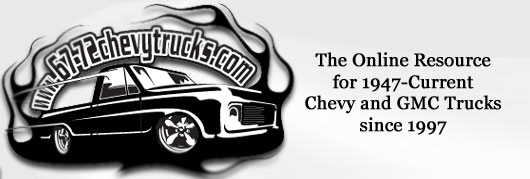
 |
Register or Log In To remove these advertisements. |
|
|
|
|||||||
 |
|
|
Thread Tools | Display Modes |
|
|
|
|
#1 |
|
Moderator
 Join Date: Oct 2008
Location: Wentworth, NH
Posts: 5,022
|
Re: Carbureted 350 vacuum line rebuild
If it's a manual transmission with California emissions it's possible it originally had Transmission Controlled Spark Advance in 1970. That would explain the thermo vacuum valve in the thermostat neck.
You do want the PCV valve running to manifold vacuum and the PCV intake running to a filter in the air cleaner or a filter cap in the valve cover opposite the PCV valve. This will keep the crankcase seals from weeping motor oil. The 1967-72 trucks had the fuel tank mounted with you behind the driver seat inside the cab. You have to put some kind of hose arrangement on the tank vent to carry the raw fuel vapor out of the cab. Vented fuel caps aren't an option. The filler is right next to the drivers side door. Three hose EVAP cans like the 70's F-bodies and Vettes used are simple and easy to install. They have zero negative effect on performance and they'll keep the garage or barn from smelling like raw fuel. They have ported vacuum to the purge control valve, fuel vent from the tank, and purge teed into the PCV valve hose for manifold vacuum to suck out the trapped fuel vapor. In short the charcoal EVAP can is a good thing. If it's parked outside you could just run an SAE J30R7 fuel vapor hose from the vapor connection on the fuel sender to an axle vent. You'll occasionally smell raw fuel using this setup. The other simple venting option would be to do what Nissan did with the Datsun 210... put an axle vent inside the air cleaner filter ring and run the tank vent hose up to that.
__________________
1959 M35A2 LDT465-1D SOLD 1967 Dodge W200 B383, NP420/NP201 SOLD 1969 Dodge Polara 500 B383, A833 SOLD 1972 Ford F250 FE390, NP435/NP205 SOLD 1976 Chevy K20, 6.5L, NV4500/NP208 SOLD 1986 M1008 CUCV SOLD 2000 GMC C2500, TD6.5L, NV4500 2005 Chevy Silverado LS 2500HD 6.0L 4L80E/NP263 2009 Impala SS LS4 V8 RTFM... GM Parts Books, GM Schematics, GM service manuals, and GM training materials...
And please let us know if and how your repairs were successful. |
|
|

|
|
|
#2 | |
|
All about them K’s
 Join Date: Jun 2014
Location: Land of Entrapment
Posts: 6,601
|
Re: Carbureted 350 vacuum line rebuild
Quote:
You are correct about the trans spark switch I had forgotten about that. Mine didn’t/doesn’t have it. Here’s a picture of the sending unit setup his truck likely has. I do agree there isn’t a huge issue against adding a canister (other than gathering the necessary parts) but it’s likely his truck didn’t have one originally.
__________________
Tyler '57 3100 http://67-72chevytrucks.com/vboard/s...d.php?t=813888 '72 K20 Cheyenne: 5” lift, 35’s, front dana 60 blah blah blah… http://67-72chevytrucks.com/vboard/s...d.php?t=662879 ‘69 K10 SWB: 4” lift 33”s… in a million pieces http://67-72chevytrucks.com/vboard/s...d.php?t=805206 '98 Silverado LT K2500HD ECLB Vortec 454/4l80E: 6" lift 35x12.5x20’s Last edited by 57taskforce; 04-05-2020 at 10:12 PM. |
|
|
|

|
 |
| Bookmarks |
|
|